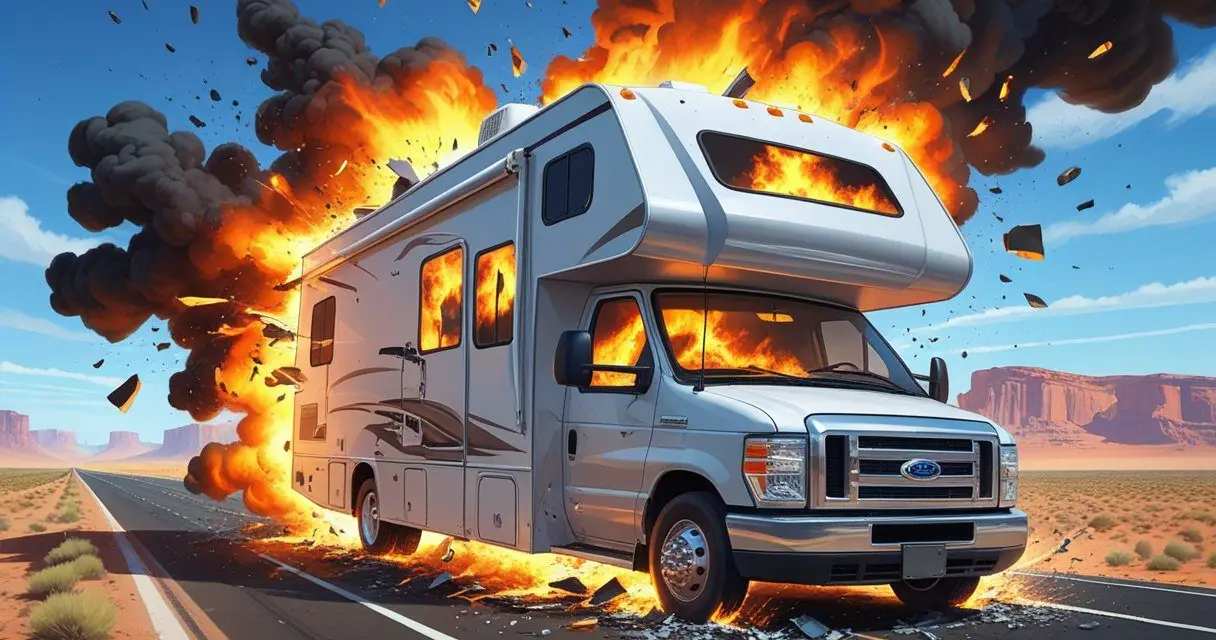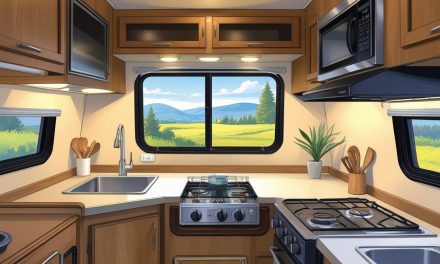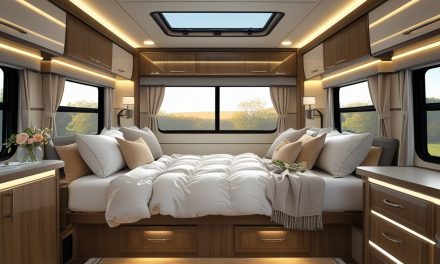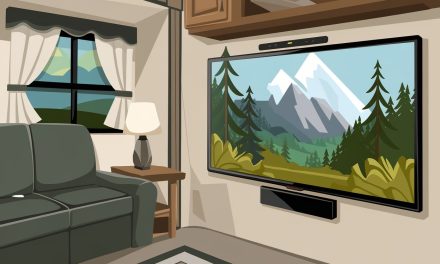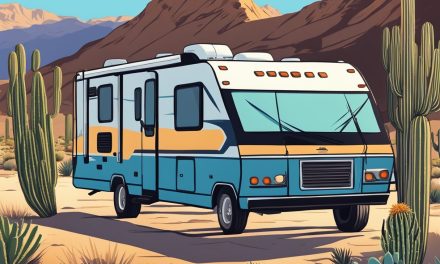Would you like to save this article?
You dream of hitting the open road, exploring national parks, and living the RV lifestyle with your family. But what happens when that dream turns into a toxic nightmare that forces you to evacuate your home on wheels?
The heartbreaking story of Grant, Kalei, and their young daughter reveals the dark side of RV ownership that dealerships don’t want you to know about. Their brand-new 2021 Keystone Fusion 427 became a health hazard so severe that they had to abandon everything and flee for their lives.
From manufacturing defects to deadly mold contamination, this video exposes the shocking realities lurking beneath the shiny exterior of America’s booming RV industry.
If you’re considering buying an RV, these seven eye-opening revelations will change everything you thought you knew about recreational vehicle ownership.
1. Manufacturing Defects: When “New” Doesn’t Mean “Safe”
Your brand-new RV straight from the factory might be a disaster waiting to happen. Grant and Kalei discovered this harsh reality when their washing machine’s P-trap was installed completely upside down by the manufacturer.
This single error caused water to pour through their floors for months, creating the perfect conditions for what would become a life-threatening mold infestation.
Industry statistics reveal this isn’t an isolated incident. According to a 2024 industry analysis, 70% of new RVs have at least one major defect upon delivery. The RV industry has more recalls than the automobile industry, with common issues including faulty water heater control boards, shorted wiring, and improperly sealed components.
| Common RV Manufacturing Defects | Percentage Affected |
|---|---|
| Plumbing/Water System Issues | 45% |
| Electrical Problems | 38% |
| Structural Defects | 32% |
| Appliance Failures | 29% |
You might wonder why such expensive recreational vehicles have so many problems. The answer lies in manufacturing practices that prioritize speed over quality. Workers are often paid by piece rate, incentivizing rapid assembly rather than careful craftsmanship. As one industry insider revealed, “Some former workers say the system encourages speed over thoroughness.”
2. Water Damage: The Silent Destroyer
Water damage in RVs isn’t just about a little moisture – it’s about complete structural devastation. When Grant and Kalei’s washing machine leaked, they trusted the technician who said the insulation would “dry out quickly.” Five months later, that same insulation was still soaking wet, creating a breeding ground for dangerous microorganisms.
The couple discovered water had saturated their floors, walls, and personal belongings. Kalei found her dress with a waterline halfway up, revealing just how extensive the moisture problem had become. The water damage affected not just the immediate area but spread throughout their living space, contaminating everything they owned.
RVs are particularly vulnerable to water damage due to their construction methods. Unlike traditional homes, RVs use lightweight materials that aren’t designed for constant moisture exposure. When leaks occur – and they frequently do – the damage spreads rapidly through particle board floors, thin wall panels, and inadequate insulation systems.
You should know that water damage in RVs often leads to total loss scenarios. The compact nature of RV construction means that moisture can quickly spread to critical systems, making repairs more expensive than the vehicle’s value.
3. Toxic Mold: The Hidden Health Hazard
The most shocking revelation from this nightmare involves deadly mold contamination. When Grant and Kalei finally hired a professional mold inspector, the results were terrifying: “extremely elevated levels of Stachybotrys,” considered the most toxic black mold. The inspector became physically ill from just one day of exposure and ordered the family to evacuate immediately.
Mold in RVs poses unique dangers due to the confined living space. Unlike houses where mold might affect one room, RV mold contamination spreads throughout the entire living environment. The family experienced severe health symptoms including:
- Severe abdominal pain and breathing difficulties
- Chronic headaches and migraines
- Skin rashes and sinus problems
- Hospitalization and emergency surgery
The health impact was so severe that Kalei was diagnosed with mold illness and required extensive medical treatment. She underwent multiple hospitalizations and had to follow strict mold detox protocols just to survive the exposure.
You might not realize how quickly mold can colonize an RV environment. The combination of moisture, warmth, and poor ventilation creates ideal conditions for rapid mold growth. Once established, mold spores spread through air conditioning systems, furniture, and personal belongings, making complete remediation nearly impossible.
4. Contaminated Belongings: Losing Everything
Perhaps the most heartbreaking aspect of this story involves the complete loss of personal possessions. Following professional guidance, the family had to discard 90% of their belongings due to cross-contamination. This wasn’t just about replacing a few items – they lost irreplaceable memories, important documents, and sentimental treasures.
The contamination was so extensive that Grant had to re-enter the toxic RV wearing a hazmat suit to salvage what little they could save. Even items that appeared unaffected required specialized disinfection procedures. The family lost:
- All homeschooling materials and educational resources
- Legal documents and important papers
- Their daughter’s stuffed animals and toys
- Personal care items, food, and medications
- Office equipment and work materials
You should understand that mold contamination doesn’t just affect the RV structure – it destroys lives. The financial impact of replacing “thousands and thousands of dollars of personal belongings” added insult to injury for a family already dealing with a defective RV and mounting medical bills.
The emotional toll on their young daughter was particularly devastating. Watching a child grieve the loss of treasured possessions while dealing with fear about mold exposure shows how these RV nightmares affect entire families, not just the adults who made the purchase decision.
5. Dealership Disasters: When Customer Service Fails
Your RV problems don’t end with manufacturing defects – they’re often made worse by incompetent dealership service. Grant and Kalei’s experience with Camping World reveals a pattern of poor workmanship, incomplete repairs, and outright negligence that turned a manageable problem into a catastrophe.
The dealership’s handling of the repairs was nothing short of professional malpractice. They claimed repairs were complete after just three days when the work wasn’t even started. When the family returned, they found:
- Water-damaged materials left in place
- Debris scattered throughout the RV
- Promised repairs never performed
- New damage caused by careless work
The most egregious incident involved the dealership damaging the hitch and then blaming the customers for the damage. When confronted, their solution was to “beat it with a hammer” to straighten it out – exactly the kind of unprofessional approach that characterizes much of the RV service industry.
You’ll discover that finding competent RV service is nearly impossible in many areas. The industry’s rapid growth has outpaced the development of skilled technicians, leaving RV owners at the mercy of undertrained workers who often create more problems than they solve.
6. Corporate Cover-Up: When Manufacturers Won’t Take Responsibility
The manufacturer’s response to this obvious defect reveals the industry’s culture of denial and deflection. Despite commissioning a thorough two-hour inspection that documented extensive damage, Keystone refused to provide the family with a copy of the report they paid for. The inspector privately told the family this was clearly a buyback situation, but Keystone offered only minor repairs that had nothing to do with the actual damage.
Even more shocking was Keystone’s claim that no inspection report existed when the family’s attorney got involved. This blatant dishonesty shows how far manufacturers will go to avoid taking responsibility for their defective products.
The company’s final offer of $2,000 to “basically just go away” demonstrated complete disregard for the family’s health, financial losses, and emotional trauma. This insulting settlement offer came after the family had already spent far more than that on medical bills, mold remediation specialists, and replacing contaminated belongings.
You should know that manufacturer warranties are often worthless when serious defects occur. Legal experts warned that the family’s cooperation with the manufacturer actually hurt their case, as companies use the warranty process to run out legal deadlines while avoiding real responsibility.
7. Legal Limbo: When the System Fails Victims
The legal system offers little protection for RV defect victims. Despite clear evidence of manufacturing defects that created dangerous conditions, Grant and Kalei discovered they were outside the timeframe for lemon law protection. Their attorney ultimately abandoned their case, stating that Keystone wouldn’t help and advising them that cooperating with the dealership and manufacturer had “screwed” their legal position.
The family learned too late that immediate legal action is essential when dealing with RV defects. By the time they realized the extent of their problems, legal remedies were no longer available. This highlights a critical gap in consumer protection laws that favors manufacturers over victims.
RV lemon laws vary significantly by state and often have restrictive timeframes that don’t account for the complex nature of RV defects. Unlike automotive lemon laws, RV protections are often weaker and harder to enforce, leaving consumers with few options when facing defective vehicles.
You need to understand that the current legal framework heavily favors manufacturers. The combination of weak warranty protections, restrictive lemon laws, and the industry’s ability to delay resolution creates a system where victims bear the full cost of manufacturer negligence.
Industry Response and Current Status
Following Liz Amazing’s intervention, Keystone finally offered to address the situation. The manufacturer proposed either factory repairs or a potential buyback, though negotiations are still in early stages. This response only came after public pressure from the viral video exposure – highlighting how consumer advocacy channels have become more effective than traditional legal remedies.
The RV industry continues to face increasing scrutiny over quality control issues. A recent Wall Street Journal exposé characterized the problems as “serial breakdowns,” noting that manufacturing errors, insufficient oversight, and rushed production continue to plague the industry.
Full-timers face a 50% higher repair rate than occasional users, demonstrating that RV construction simply isn’t adequate for its intended use. This statistic should concern anyone considering the RV lifestyle, as the vehicles often fail when subjected to regular living conditions.
Conclusion: The Real Cost of RV Dreams
This family’s nightmare reveals the true cost of RV ownership extends far beyond the purchase price. Medical bills, lost belongings, legal fees, and emotional trauma can easily exceed the value of the RV itself. Their story serves as a warning that the glamorous RV lifestyle marketed by manufacturers and dealers conceals serious risks that can destroy families financially and physically.
Before purchasing any RV, you must demand transparency from manufacturers and dealers. Insist on detailed construction specifications, comprehensive inspections, and ironclad warranties that actually protect your interests. Most importantly, understand that when things go wrong in the RV industry, you’ll likely be fighting alone against well-funded corporations with little incentive to make things right.
The RV industry’s continued growth depends on addressing these systemic quality issues. Until manufacturers prioritize safety and durability over profit margins, stories like Grant and Kalei’s will continue to plague families who simply wanted to explore America’s natural wonders with their loved ones.
SOURCES
- Evacuated: Forced to leave our RV – Liz Amazing YouTube Channel
- Under the Hood: RV Manufacturing Quality and Construction Realities
- Industry Exposed for RV Quality Problems – RV Lifestyle
- Mold In Campers: A Dangerous Health Hazard – ShunAuto
- Warning Signs of Camper Mold Toxicity – RV Troop
- Uncovering Keystone RV Problems: Are They Worth the Hype?
- Keystone RV Reviews and Complaints – PissedConsumer
- Wall Street Journal – RV Industry Quality Issues

